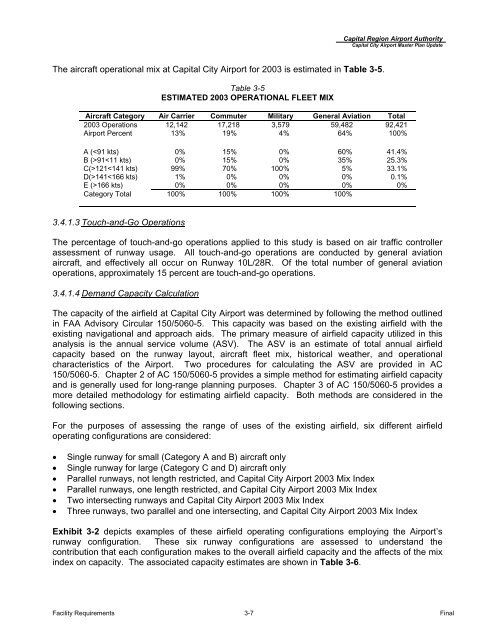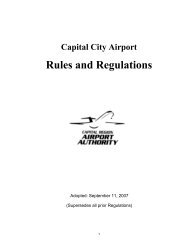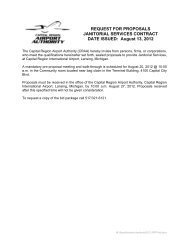Master Plan Update (pdf) - Lansing/Capital City Airport
Master Plan Update (pdf) - Lansing/Capital City Airport
Master Plan Update (pdf) - Lansing/Capital City Airport
Create successful ePaper yourself
Turn your PDF publications into a flip-book with our unique Google optimized e-Paper software.
The aircraft operational mix at <strong>Capital</strong> <strong>City</strong> <strong>Airport</strong> for 2003 is estimated in Table 3-5.<br />
Table 3-5<br />
ESTIMATED 2003 OPERATIONAL FLEET MIX<br />
<strong>Capital</strong> Region <strong>Airport</strong> Authority<br />
<strong>Capital</strong> <strong>City</strong> <strong>Airport</strong> <strong>Master</strong> <strong>Plan</strong> <strong>Update</strong><br />
Aircraft Category Air Carrier Commuter Military General Aviation Total<br />
2003 Operations 12,142 17,218 3,579 59,482 92,421<br />
<strong>Airport</strong> Percent 13% 19% 4% 64% 100%<br />
A (91121141166 kts) 0% 0% 0% 0% 0%<br />
Category Total 100% 100% 100% 100%<br />
3.4.1.3 Touch-and-Go Operations<br />
The percentage of touch-and-go operations applied to this study is based on air traffic controller<br />
assessment of runway usage. All touch-and-go operations are conducted by general aviation<br />
aircraft, and effectively all occur on Runway 10L/28R. Of the total number of general aviation<br />
operations, approximately 15 percent are touch-and-go operations.<br />
3.4.1.4 Demand Capacity Calculation<br />
The capacity of the airfield at <strong>Capital</strong> <strong>City</strong> <strong>Airport</strong> was determined by following the method outlined<br />
in FAA Advisory Circular 150/5060-5. This capacity was based on the existing airfield with the<br />
existing navigational and approach aids. The primary measure of airfield capacity utilized in this<br />
analysis is the annual service volume (ASV). The ASV is an estimate of total annual airfield<br />
capacity based on the runway layout, aircraft fleet mix, historical weather, and operational<br />
characteristics of the <strong>Airport</strong>. Two procedures for calculating the ASV are provided in AC<br />
150/5060-5. Chapter 2 of AC 150/5060-5 provides a simple method for estimating airfield capacity<br />
and is generally used for long-range planning purposes. Chapter 3 of AC 150/5060-5 provides a<br />
more detailed methodology for estimating airfield capacity. Both methods are considered in the<br />
following sections.<br />
For the purposes of assessing the range of uses of the existing airfield, six different airfield<br />
operating configurations are considered:<br />
• Single runway for small (Category A and B) aircraft only<br />
• Single runway for large (Category C and D) aircraft only<br />
• Parallel runways, not length restricted, and <strong>Capital</strong> <strong>City</strong> <strong>Airport</strong> 2003 Mix Index<br />
• Parallel runways, one length restricted, and <strong>Capital</strong> <strong>City</strong> <strong>Airport</strong> 2003 Mix Index<br />
• Two intersecting runways and <strong>Capital</strong> <strong>City</strong> <strong>Airport</strong> 2003 Mix Index<br />
• Three runways, two parallel and one intersecting, and <strong>Capital</strong> <strong>City</strong> <strong>Airport</strong> 2003 Mix Index<br />
Exhibit 3-2 depicts examples of these airfield operating configurations employing the <strong>Airport</strong>’s<br />
runway configuration. These six runway configurations are assessed to understand the<br />
contribution that each configuration makes to the overall airfield capacity and the affects of the mix<br />
index on capacity. The associated capacity estimates are shown in Table 3-6.<br />
Facility Requirements 3-7 Final




